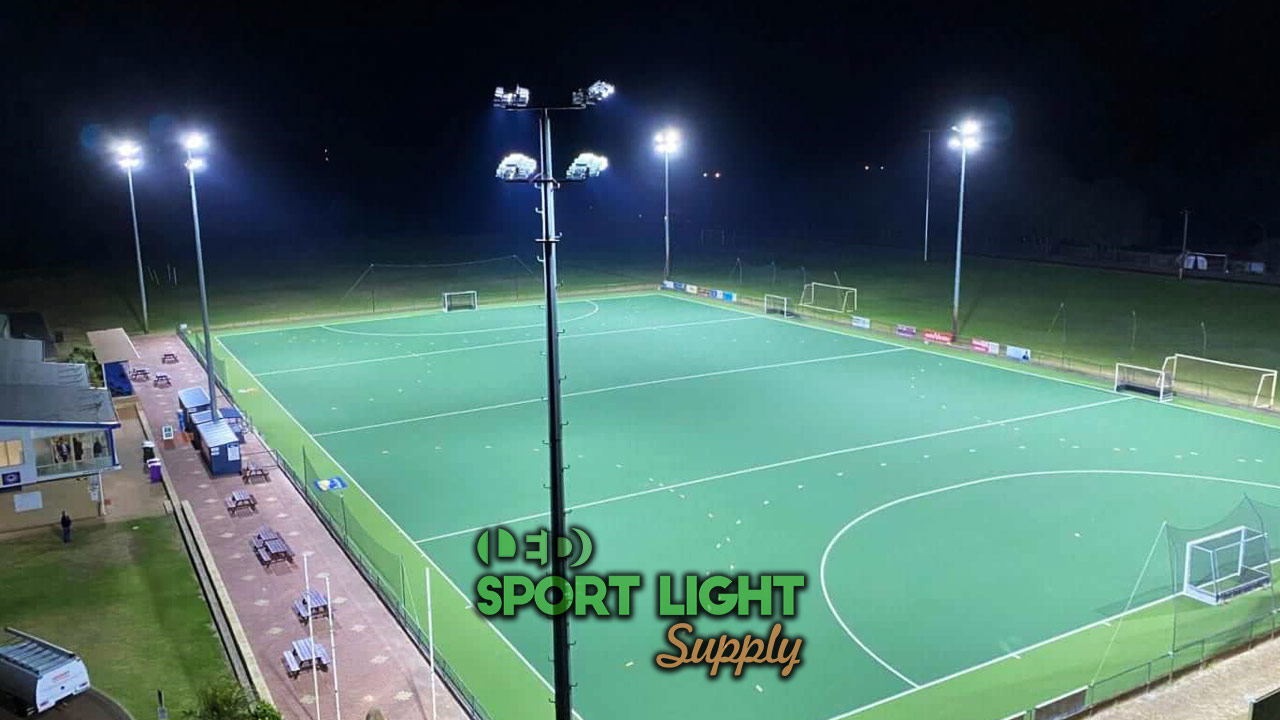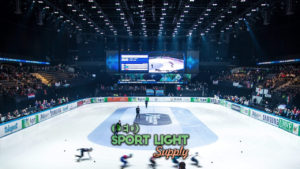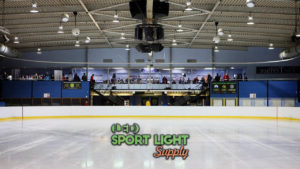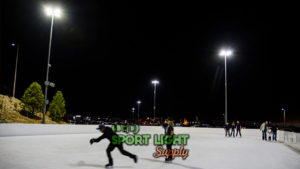The world’s best hockey players start practicing the game at an early age. Usually, they spend many hours on the hockey field as they grow up. Most of them will play both indoor and outdoor matches before choosing their favorite position. So, satisfying the safety standard is one of the top priorities.
Of course, the lighting design of a hockey stadium plays a big role in ensuring safety and playability. By using LED lights and planning a layout that follows the current regulation, no elements on the hockey pitch must pose a threat. But some aspects of the standard may seem confusing. So, this brief guide streamlines the rules, hoping to speed up the learning process.
What lighting fixtures are used in the field hockey pitch?
1. High power flood lights
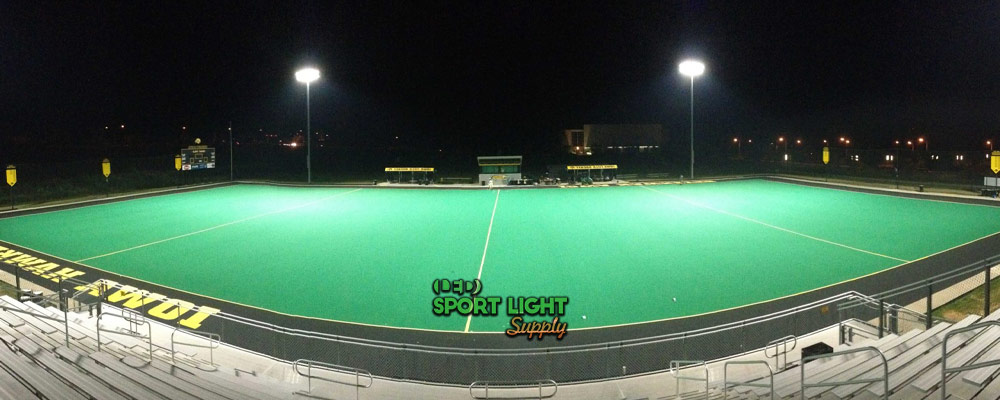
The flood light is one of the most standard pieces of lighting equipment. At a glance, the modern LED flood light contains nine parts:
- protective tempered glass
- LED chip
- aluminum reflector
- silicone ring
- aluminum housing
- G shape buckle
- protection cover for screw
- driver
- bracket
Just like the spot light, a flood light is versatile. You can use it virtually anywhere in the hockey stadium. For example, on the ceiling, walls, or on a base. But its broad beam angle is what really makes it unique. Flood lights are great for short-range illumination.
High power flood lights also have a heat sink to help the LED chip dissipate heat. Plus, you can control them individually to help establish a more professional atmosphere for special facilities and events.
As long as their use complies with the regulation, lighting designers can integrate them to improve illuminance. Or they can suggest points in the design where additional flood lights could be installed.
Grouping some flood lights can be a smart way to cut expenses during training. Or anytime a lower standard is acceptable.
2. High mast lights
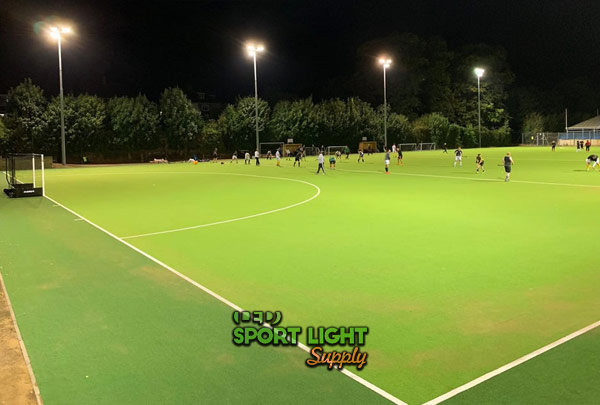 High-mast lighting involves the use of light sources on a high mast. Of course, the larger the hockey field, the higher you need to mount the lights. High-mast lights are a cost-effective way to employ the best lighting design available.
High-mast lighting involves the use of light sources on a high mast. Of course, the larger the hockey field, the higher you need to mount the lights. High-mast lights are a cost-effective way to employ the best lighting design available.
With this lighting solution, it is not just about how much light you get on the hockey pitch. In fact, it is about where the light goes.
Standard reflectors like flood lights and spot lights cast the light where it is needed. Thanks to the LED tech, better lenses can also give us more precision, thus avoiding light pollution. But with high-mast lighting, the light spill can be a cause of concern for the neighborhood.
Optic lenses are a great solution to meet the minimal tilt requirements. Above all, their fixed position must not cause glare for the spectators, players, and umpires. Depending on the location of the field hockey pitch, high mast lights must not disturb the nearby drivers either.
The main benefit of high-mast lighting is improved visibility. More specifically, a better uniform vertical illumination. Among other lighting solutions, high masts provide the greatest lighting coverage. With an accurate lighting design and layout, you can reduce:
- the light pole locations
- operating and maintenance costs
- initial material
- installation costs
3. Spot lighting
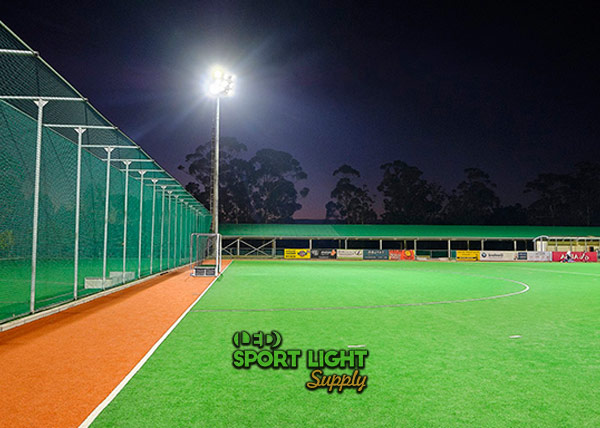 Generally speaking, spot lights are not the main source of lighting for the whole hockey field. Their function is to provide extra light over a large area, thus increasing horizontal uniformity. Or focus on a precise spot like the penalty spot inside the shooting circle.
Generally speaking, spot lights are not the main source of lighting for the whole hockey field. Their function is to provide extra light over a large area, thus increasing horizontal uniformity. Or focus on a precise spot like the penalty spot inside the shooting circle.
When more spot lights focus on the same area from different angles and positions, they can remove shadows. Spot lighting is essential for illuminating the goal area. But they also light up the center at the beginning of each game.
The typical spot light is similar to a flood light. But it has a lens rotating ring to adjust the beam of light. Usually, you can reduce or increase the light that passes through the lens. In this way, you can further decrease the narrow beam.
Of course, spot lights are for long-range use only. You can attach the yoke to most surfaces of the hockey stadium or screw it in. Instead, a bigger and professional spot light can be quite heavy and need a dedicated stand.
4. High bay lights (indoor use only)
A high bay light is a fixture with an acrylic or aluminum dome and a ballast box right above it. In the past, metal halide high bay lights were popular. But today, you can easily retrofit them with more convenient LED lights.
Most high bay lights use a light source with a wattage between 100 and 400 Watts. Also, this means that the standard fixture uses a mogul base. So, you can buy LED retrofit units with a mogul adapter and quickly replace the metal halide light source. Of course, you will have to remove the ballast and attach the LED driver that comes with the retrofit.
Installation of a LED retrofit only takes 15 to 20 minutes per fixture. Below you will read more about the metal halide LED replacement’s benefits.
High bay lights cast their light vertically. So, many of them are necessary by design. For the indoor hockey field, the total number depends on the lighting style (direct or a mix of direct and indirect) and pitch dimensions.
Often, indoor facilities have multi-sports turf pitches. So, most indoor hockey stadiums have at least fourteen high bay lights.
5. Panel lights (indoor use only)
Panel lights are used for commercial illumination of many buildings and offices. In the hockey stadium, you need many panel lights to meet the lighting standard. They have a large emitting surface, so they spread their nominal lumen output and cause little or no glare.
Inside the casing, a layer of white, reflective material will reflect or defuse any ray. In general, the three components that make a panel light are:
- a sturdy aluminum housing
- the SMD LED (surface-mount device or panel) with or without diffuser lens and polarizing films
- a surface mounting frame
Different manufacturers may employ production techniques and materials that give varying results. Usually, higher efficacy comes with higher manufacturing costs. Plus, the next-generation backlit tech could come with very different specs. On the plus side, you can choose among several sizes. Besides, they adapt well to many types of ceilings and layouts.
Thanks to available accessories, you can mount light panels on even surfaces or as suspended and recessed lights. In the end, they are versatile. Most indoor hockey stadium owners prefer them to high bay lights for new projects. Mainly because they create a more modern ambience.
6. Solar LED lights
Solar tech has the potential of reducing your operating costs. Of course, the fixtures house low-power lights. So, their use is recommended for recreational only. Each fixture comes with a solar panel or module which gathers the sunrays and turns them into electricity.
With the portable models, no wiring is necessary for outdoor hockey pitches. You can just install the light where they need to be. But you can also choose a single, big panel and install a larger battery for all the lights.
Cleaning the solar module is a fundamental part of the periodic maintenance routine. In fact, dust, debris, dirt, and snow can slow or halt the conversion process. The same goes for cloudy and rainy days. On average, solar cells need as long as six to eight hours per day to fully recharge.
Investing in renewable energy can be beneficial. But you need to consult with a lighting designer. Mainly to ensure they can meet the minimum standard for training. In the long term, solar energy can reduce costs considerably. Plus, they are portable lighting solutions you can repurpose easily.
What are the lighting requirements of the hockey pitch?
1. Lux and footcandle standard
Lux and footcandles help us to achieve adequate brightness on the hockey field. In fact, the farther away you get from a light source, the lower the light level goes on a given surface. So, you need to increase the light intensity by adding more lighting devices. Or you could also replace the light sources with more powerful lights.
Of course, it would be a problem to come up with a way to measure brightness if the standard change with the distance. So, lux and foot candles express a value you need to reach no matter the light sources’ layout. The lux involves the lumen, which is the unit of measure for the light intensity of any lamp.
When on a package you read its lumen rating, you can judge how strong the lamp’s luminous flux is. Both lumen and lux are used in the Metric System. In the US, the Imperial system has different units and values. The foot candle is the equivalent of the lux and the candela for the lumen. The conversion requires you to convert each foot candle in 10,76 lux.
The formula to get to the lux measurement is the total lumen output divided by the surface area. So, in the Metric System, lux is measured in lumens per square meter. In the US, you have candelas per square foot. Sometimes, lumens are used instead of candelas as well.
Lux standards for the field hockey pitch
Televised and non-televised hockey events require different lighting requirements. In brief, the standard for non-televised events is lower. So, you only need 200 lux for training and 250 lux for low grade club competitions. For national clubs and international competitions, you should have at least 500 lux.
Instead, for televised matches, the regulation applies higher standards. Not only that, but it also requires a vertical illuminance. This means you need to ensure a lux reading both horizontally (Eh) and vertically (Eh). Regional matches need an Eh of 800 to 1000 lux and an Ev of at least 750 lux. For national events, Eh should read between 1,500 and 3,000, and Ev at least 1,400 lux. Finally, international matches and events should also have an Eh between 1,500 and 3,000, but Ev should be no less than 2.000.
All these values are to be considered as maintained lux readings. That is, no fluctuations in light quality are expected during the game.
2. Lighting uniformity requirement
Once you achieved the desired lux value, you need to ensure that the light distribution follows the standard. In other words, a striker should not enter an attacking zone and suddenly enter a dim-lit area. This would benefit the defense and confuse or distract the sprinting player.
Lighting uniformity is about taking several lux readings on the hockey pitch. In fact, you need to divide the hockey field into a grid to do this. Then, you collect all the data from all the spots. After that, you can calculate both the overall uniformity (Uo) and longitudinal uniformity (Ul).
First, you take the lowest reading on the hockey field grid. Then, you divide it by the highest reading, thus getting the Ul value. Or the average value from all the other readings, thus finding the Uo.
As you can guess, you take the horizontal uniformity on the ground and the vertical uniformity at the players’ height. For non-televised and televised games, the Ul and Uo must be at least, respectively:
- 0.5 and 0.7 for training, local, and national, and international competitions
- 0.65 and 0.7 (both horizontally and vertically) for televised regional and national competitions
- 0.7 and 0.8 (both horizontally and vertically) for televised international competitions
3. Color temperature
This metric describes the warmth or coolness of the light sources. In detail, the color temperature spectrum is measured in Kelvin degrees. For example, at 3,000 K the temperature scale gives you a warm with color. At 4,000 K, the white light is neutral, with a faint yellowish hue. Instead, at 6,000 K, the light turns cool white.
For any level of competition and purpose, the color temperature in a hockey stadium must be above 4,000 K. Usually, most stadium owners use a 5,000 K as it resembles daylight. Besides, broadcasters may make their requests to match the lighting with their professional cameras and equipment.
Each person perceives different color temperatures differently, so getting LED lights is a good idea. In fact, most LED devices let you change the color temperature.
If you are not using LED lights, you should be aware that traditional light sources have a specific color temperature. For example, metal halide lights cast a bluish light. Instead, halogen bulbs emit rays with a yellowish tone. Read the specs sheet of each light for more information.
4. Color rendering index (CRI)
The type of light source you install in the hockey stadium makes a remarkable difference in the color appearance. When using low-quality lamps, the colors of the grass, uniforms, ball, and so on look dull. This happens because the quality of light changes with the quality of the light source materials and their efficiency.
CRI gives us a way to understand how good the light source renders colors. Technically speaking, the benchmark for CRI is set by sunlight. In fact, sunrays contain all the colors we can perceive, also known as a continuous spectrum. Therefore, the sun has a CRI of 100 Ra.
Sadly, not every light produces light as beautiful as the sun. In their spectrums, you can find gaps that equal color loss. Most manufacturers may try to hide this metric if the lights are very bad. That is, they have a CRI of less than 50 Ra.
For playing hockey, you need at least a CRI higher than 65. Usually, high-quality LED lights have a CRI of 95 Ra or higher. So, they tend to be the best options for long-lasting high-quality rendering. After all, the CRI value goes down as the light source age.
5. Anti-glare
In outdoor hockey venues, glare control ensures a fast-paced action. Center forwards are calm and composed under pressure. But they also must have good shooting skills because they must take any opportunity to score. Of course, they cannot run down the wings or sprint if they get blinded by the lights, so a glare rating of less than 50 must be maintained at all times.
With high-mast lighting, glare and spill light are common problems. But you can modify the tilt angle and install shieldings to fix both issues. For a similar reason, spotlights should never be directly in the goalkeepers’ line of sight. Lenses, glasses, and films are available for diffusing light. But in the end, the design should take care of glare with better positioning.
In indoor hockey stadiums, you can achieve soft light with indirect lighting. In this way, the light bounces off the wall to the hockey pitch. But in this case, you need more powerful LED light sources. Wider beam angles can also help, so adding flood lights to the layout can prevent glare.
6. Flicker-free (for broadcasting)
Flicker refers to the modulation of a LED light output. In detail, flickering happens at a much faster rate than the human eye can see. But video cameras pick it up because the recording is based on several images per second. So, flickering creates image quality issues. Especially in slow-motion replays.
By design, flicker-free LED lights have components in the drivers that remove the flicker. On balance, flicker-free LED lights cost a little more than standard LED lights. But they ensure better images and are better for the health and wellness of people exposed to them.
In fact, some people are more sensitive to fluctuations in light output than others. The effects can be distracting or painful.
An alternative way to eliminate flickering is to use direct current. As you know, electric light requires a power source. Yet, the AC power system does not provide constant electricity. In fact, it is in the name as AC stands for alternating current. AC delivers power in a very fast fluctuation that we measure as a frequency. And the flicker depends on the frequency of the power system.
How to achieve the best lighting design for the hockey field?
The hockey stadium design process must abide by the current regulation. Luckily, the design can be as flexible as needed. But you should go through this list to identify the most crucial factors:
- What is the maximum level of play that the field hockey pitch is going to host?
- Will broadcasters stream the matches?
- Define your budget.
- Contact a professional lighting engineer to create a first lighting design and layout.
- Consult architects and mass media outlets for necessary modifications (if you will host televised games)
- Integrate existing or new lighting solutions to ensure accuracy and easy maintenance routines
- After installation, perform calibration tests
As you can see, determining whether broadcasters will or will not be involved impacts the following steps. Above all, you should have clear goals for your sports facility in your mind. Then, modify the project accordingly to meet the required lighting standard.
Hockey pitch lighting layout
1. Light pole height
The high-mast lighting design must be efficient and cause no light spill problems. So, the light pole height must change with the layout. After all, as the number of poles goes up, shorter light poles are enough for adequate brightness on the outdoor hockey pitch.
For the full-size hockey field, one of the three main layouts can be in place. That is, a 4-, 6-, or 8-pole layout. Apart from the 8-pole layout, the light pole on the side must be no taller than 18 meters. Instead, light poles in the corners can go up to 21 meters. Of course, you need a setback from the field boundary of 5 meters. When using a total of 8 light poles, the height can decrease to 15 meters.
For the hockey5s court, light poles along the sidelines should be 12 meters tall. Instead, light poles in the corners can go as high as 15 meters. These values must include a setback of 3 meters from the field boundary to be valid.
2. Number of light poles
As briefly mentioned, three layouts are popular for the full-size hockey field. The 4-pole layout is most affordable. Generally, it includes 4 light poles at the corners of the field. But sometimes, two light poles at opposite corners while the other two are arranged on the sides. Mostly, you find this layout in outdoor multi-sport facilities and parks.
A 6-pole layout is a more refined design. With enough light to illuminate the halfway line, midfielders can play in tight spaces and make better decisions under pressure. Because they are strong on the ball, the two additional lights help them dribble with the ball and receive perfectly. After all, the spaces in the midfield are the most crowded.
Finally, the 8-pole layout offers the best coverage. For example, the defenders can make good interceptions. Plus, they can make full use of their skills as they are good at reading the game. Similarly, fast players attacking with speed can take risks safely trying to score.
For hockey5s courts, 4- and 6-pole layouts are more than enough.
3. Position of light pole
For safety reasons, you must place the high masts outside the overrun area. Players can run at high speed, and even though no shoulder barge is allowed, it can happen. So, you must always take into account space of at least 5 meters beyond the backlines and at least 6 meters from the sidelines.
Sometimes, for the full-size hockey pitch, the 4-pole layout includes no corner arrangement. Instead, the lighting designer places the poles near the 25-yard lines.
As the number of poles increase, the high mast arrangement focuses less on the goalkeepers and more on the central area. When using a 6-pole layout, two light poles illuminate the centerline. Visual comfort increases for both the players and the spectators. With the 8-pole layout, the soft light eliminates shadows and ensures better playability.
Since the hockey5s court is small, four light poles at the corners provide enough brightness. But you can always add two more high masts at the centerline for better results.
4. Ceiling height (for indoor hockey pitch lighting layout only)
During the planning phase, the ceiling height influences several factors. For example, the number of light sources or the spacing between them. The main goal is to ensure good visibility by fulfilling the lighting criteria. That is, the lighting standards you read above like illuminance (lux or foot candles), uniformity, color temperature, etc.
The best layout causes no shadowing on the indoor hockey pitch. At the same time, the positioning cause no glare and reliable contrast thanks to high-CRI light sources.
With low ceilings, recessed and surface-mounted lighting solutions are necessary. Instead, with high ceilings, you can use pendent fixtures and use longer cords as needed.
For televised matches, close liaison with the broadcasters is highly advised. Mainly because their requirements will depend on the video camera equipment and video production techniques.
Metal halide LED replacement of hockey field lights
HID lighting has been used for the last three decades. But today, LED lights to offer a more energy-saving and cost-effective alternative. Above all, LEDs have a longer life span that allows for better lumen maintenance over the years. In brief, lumen maintenance refers to the non-recoverable light loss due to overheating and supply voltage variations. The lumen maintenance curve is predictable for each type of light source.
LED lights improve as engineers develop better microchips. More importantly, LEDs produce low heat as they turn most of the electricity into visible light. So, overheating and burnouts are less common problems with LEDs. The following differences will help you understand the current situation to find the best option for your hockey field lighting system:
- Metal halide bulbs are cheaper than LED lights. But since 2008, the US Government banned the production of new MH ballasts.
- LED lights give you better options when it comes to directionality. That is, the beam angle of each fixture. Instead, most MH lights have a directionality of more than 360 degrees.
- Getting an equivalent MH LED replacement will result in low running costs. In fact, you can halve the running costs just by replacing all the old MH with equivalent LED lights.
- Maintenance costs differ as MH lights contain many components that can stop working. Instead, LED lights are compact solutions that require only periodic maintenance to clean the lens and realign the lamps.
- LEDs need no cooling period when you turn them off. Unlike LEDs, MH bulbs need to cool down between 10 and 30 minutes, depending on the room temperature.
- Dimming the lights becomes easier with LEDs. No more complex lighting systems as with any traditional lamp because new dimmable LED lights are available.
Hockey pitch lighting Q&A
1. What is the common hockey field light pole height?
It is not uncommon to see high-masts as tall as 20 meters. But optimal height gives you better illuminance and can result in reduced operating costs.
The previous section on light pole height contains all the correct variations. According to the current regulation, high masts should only be 21 meters tall when positioned in a full-size hockey field corner. Instead, a height of 18 meters is more than enough for poles on both sides. Except when the engineer designs an 8-pole layout. In that case, the light poles should be 15 meters.
When planning a high mast layout for a hockey5s court, the recommended height for poles at the corners is 15 meters. Instead, 12 meters is enough if you choose a 6-pole layout.
2. How many watts of hockey pitch lighting do I need?
As with all projects, a higher budget will result in a better outcome. So, you can expect to use anywhere from 12,000 to 180,000 watts. The key factors you need to consider include:
- lux levels (televised or non-televised matches)
- lighting uniformity requirement
- level of competition
- number of spectators
- the surrounding environment
3. How much does hockey field lighting cost?
On average, the cost can vary between $10,000 and $200,000. Depending on the field size, light pole height, level of competition, and other key factors, maintenance costs also vary.
Then again, you can invest in outdoor solar hockey field lights to cut expenses. Or replace all the old light sources with LED lights for lower operating costs. Even by changing the layout, you might end up saving more in the long run. But in the end, you can save more with a better lighting design. So, contacting experts for valuable lighting control solutions or professional reports is highly recommended.

